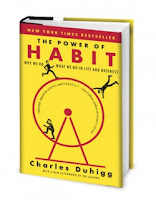HABITS
How often do you hear people
casually dismiss an inappropriate action as a “bad habit”? We want to change…but it’s so hard! We find ourselves always getting the same
results from our repeated behaviors, vowing to do better the next time. Perhaps
a first step might be to learn about habits and how to change them. With the appropriate tools, we can stop
beating ourselves up about our habits and proceed to make everlasting changes.
The book, The Power of
Habit, Why We Do What We Do In Life and Business, was an
eye-opener for deepening my understanding that there is an ingrained method to
our routines. Unconsciously, we go
through the motions without detecting our hidden patterns. Whether our habits are quirky or normal, we
have them. Whether you floss your teeth at a certain time, tie your shoelaces
in a certain way, or drive to work using a certain route, you have habits. Unfortunately, when you want to change a
routine or habit, you may face challenges.
People who attempt to change money
habits related to saving and spending generally feel discouraged and defeated. Understand that everything we do is cyclical.
The loop begins with a cue which triggers a routine leading to a reward.
 |
| A simple neurological loop at the core of every habit |
A fairly common occurrence
happens on paydays. The cue is having
money in the bank account to trigger an event, a scheduled lunch date with friends
or coworkers. The reward is a great meal with great people. You may recognize this regular outing is becoming
an expensive venture over the long term.
Your desires are to save more and spend less. You know changes need to happen but you’re unsure
how to break the cycle. You may crave
time with your friends but the question is whether you can find other less expensive
ways.
In the short excerpt, How Habits Work, Charles Duhigg
shares his four step framework for replacing “bad habits” with “good habits.” The four steps are:
1. Identify
the routine
2. Experiment
with rewards
3. Isolate
the cue
4. Have
a plan.
In analyzing the cue, routine,
and reward, you need to identify the unfavorable habit before you can forge
ahead with a plan to change.
One of my favorite quotes in a long list of many is:
What you hear, you forget.
What you see, you remember.
What you do, you understand!
Often, I share this quote to
highlight the importance in “doing” the action step to implement a positive
change. Whether the “doing” is to lose
weight, exercise, or manage your money effectively, it’s about uncovering a new
routine to lead to the reward.
TOOLS
Since you now have a better grasp
on habits, let’s put this knowledge into action. November is Financial Literacy Month. Just
like Christmas occurs every year, Financial Literacy Month has become a major
event to aspire Canadians to take action.
This year’s Financial Literacy Theme is “Managing money and debt wisely; It pays to know.” By committing to learn one new thing, over time you will develop money
habits which inspire you to become a better money manager. Cravings are the driving force behind
habits. When you crave “financial freedom”, the longing to be
debt free or the desire to have a retirement fund, you are motivated to stick
with your plan.
In order to measure your success, you need tools. Financial tools are no different than other
tools. If you were fixing a leaky drain
pipe or sewing a button on a coat, you need them to get the job done. These valuable
financial tools, Net Worth Statement and Cash Flow Statement, were discussed in
in the previous blog, Important Tools to Have in Your Toolbox.
Net Worth Statement lists your assets (everything you own) and liabilities
(everything you owe) to determine your net worth. It isn’t surprising to learn that the
majority of people only create their Net Worth Statement when they apply for
credit (loan, mortgage, or credit card). This statement is a picture of your financial
situation. Creating this snapshot every
year provides a clear indication of how well you manage your money. Please don’t underestimate the value of this
tool. It’s a true measure of your
financial success.
A Cash Flow Statement shows precisely the income coming into your
hands and the expenses being paid over the course of a month or year. Tracking
your income and expenses determines whether you have a surplus or a shortfall
at the end of the period. At a quick
glance you also know whether you are “living
within your means”. The habit of
tracking your expenses instills more control over spending because you categorize
where your money is being spent.
FINANCIAL
FREEDOM
Whether you are developing new
habits or learning new techniques, the greatest virtues are commitment, patience,
and perseverance. I was led to believe
that new habits can be developed within 21 days. Recently I learned that’s not necessarily
correct. When this tidbit of information
circulated, somehow the words became skewed. The correct version is a new habit
may take “a minimum of 21 days.” The truth be known developing a new habit takes as long as 66 days on average. Do everything in your power to stay the course: find an accountability partner, seek a CERTIFIED FINANCIAL PLANNER® professional to assist you, and use positive self-talk reminding yourself, “You got this!” You may soon enjoy the financial freedom you have been craving.




No comments:
Post a Comment